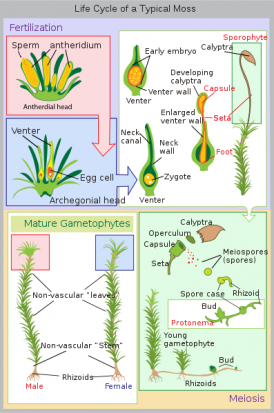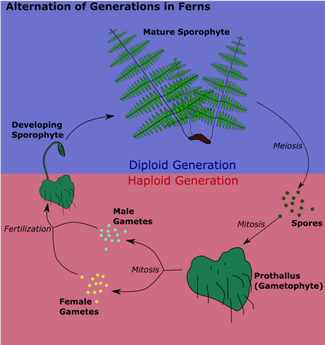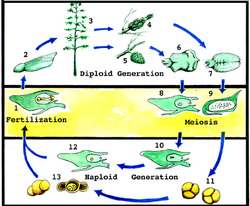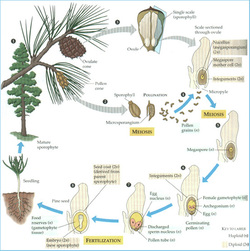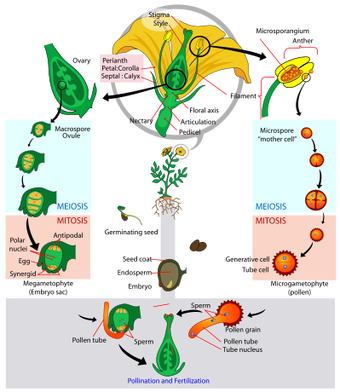Planta – 5 Essential Features and Facts of Plants

Plant Parts and Features, U.S. Wildlife Service
Plants are eukaryotic (membrane-bound nucleus) organisms that have developed photosynthesis beyond the simple, primitive photosynthesis of bacteria. Advanced photosynthesis produces oxygen, in addition to chemical energy and biochemicals.
Plants have important or unique attributes or characteristics including:
1. Photosynthesis – the ability to capture of light energy and produce biochemicals (sugars, starches, cellulose, proteins, nucleic acids, etc.). See photosynthesis notes below for further information.
2. Uptake and fixation of carbon dioxide (CO2) followed by the conversion of the molecule to useful plant molecules (see above 1)
3. Photolysis – the ability to split or dissociate water and release useful oxygen for animal use.
4. Food production and food source – plant photosynthesis sustains and maintains human and animal life by enabling plant substance to be formed and serve as food or nourishment. Plant consumption by herbivores or human vegans serves as their primary means of sustenance or staying alive.
Plant foods provide valuable minerals, vitamins, amino acids, proteins, oils, starches and useful cellulosic fiber that promotes the intestinal health of animals.
5. Cellulose production which occurs when glucose, produced during photosynhtesis, is converted by the palnts into starches and fiber or wood. The kinds of wood produced include softwoods as found in grasses and flowering plants, to firmer softwoods of pine, ash and poplar to the extremely hardwoods of maple, hickory and oak.
Photosynthesis Notes: Primitive photosynthetic bacteria were most probably the first organisms to trap and use captured light energy. The light energy of photosynthesis is used by these primitive bacteria to generate chemical energy and organic molecules. Blue green bacteria (cyanobacteria) and plants have modified and improved simple primitive photosynthesis since they have an additional photosystem that generates chemical energy, and the useful byproduct free oxygen (O2), a molecule critical for all all higher animal life.
Alternation of generations occurs as part of all complete plant life cycles with gametophyte (haploid, n, plants) and sprorophyte (diploid, 2n) stages. When studying the life cycle of plants, pay particular attention to the characteristics and features of gametophytes and sporophytes and their features such as size, morphology and role in the life cycle.
Plants have important or unique attributes or characteristics including:
1. Photosynthesis – the ability to capture of light energy and produce biochemicals (sugars, starches, cellulose, proteins, nucleic acids, etc.). See photosynthesis notes below for further information.
2. Uptake and fixation of carbon dioxide (CO2) followed by the conversion of the molecule to useful plant molecules (see above 1)
3. Photolysis – the ability to split or dissociate water and release useful oxygen for animal use.
4. Food production and food source – plant photosynthesis sustains and maintains human and animal life by enabling plant substance to be formed and serve as food or nourishment. Plant consumption by herbivores or human vegans serves as their primary means of sustenance or staying alive.
Plant foods provide valuable minerals, vitamins, amino acids, proteins, oils, starches and useful cellulosic fiber that promotes the intestinal health of animals.
5. Cellulose production which occurs when glucose, produced during photosynhtesis, is converted by the palnts into starches and fiber or wood. The kinds of wood produced include softwoods as found in grasses and flowering plants, to firmer softwoods of pine, ash and poplar to the extremely hardwoods of maple, hickory and oak.
Photosynthesis Notes: Primitive photosynthetic bacteria were most probably the first organisms to trap and use captured light energy. The light energy of photosynthesis is used by these primitive bacteria to generate chemical energy and organic molecules. Blue green bacteria (cyanobacteria) and plants have modified and improved simple primitive photosynthesis since they have an additional photosystem that generates chemical energy, and the useful byproduct free oxygen (O2), a molecule critical for all all higher animal life.
Alternation of generations occurs as part of all complete plant life cycles with gametophyte (haploid, n, plants) and sprorophyte (diploid, 2n) stages. When studying the life cycle of plants, pay particular attention to the characteristics and features of gametophytes and sporophytes and their features such as size, morphology and role in the life cycle.
Plant Features and Facts – Algae, Bryophytes, Ferns, Higher Plants
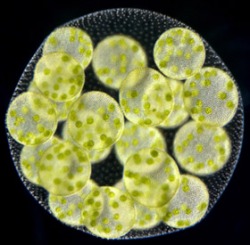
Volvox, Green Mass of Cells
Many different types of photosynthetic protistans and plants are known – algae (protistans), bryophytes, ferns, gymnosperms and angiosperms. Each group of organisms has special, structural features and characteristics. Algae are placed in the kingdom Protista, and bryophytes, ferns, gymnosperms and angiosperms are placed in the kingdom Planta.
Protistan algae are mainly residents of water (aquatic) – they spend most or all of their life in water and around water.
Bryophytes such as liverworts and mosses prefer very moist environments with a abundant and frequent supply of fresh water such as is found along the banks of streams and rivers and around waterfalls.
Many other plants such as the gymnosperms and angiosperms are terrestrial (land) plants, and they live exclusively on the land and require water in varying amounts. For example, xerophytic plants, like cacti and sagebrush require far less water than do ferns and bryophytes.
The physical features (morphology) of plants reflect their habitats and ecosystems. Most aquatic plants do not need roots to provide for the uptake of water and dissolved nutrients. Aquatic plants water and nutrients can pass directly across their walls and membranes, and enter the cells. In contrast, terrestrial plants require roots to anchor them, keep them upright, and to enable them to obtain water and nutrients from the ground.
Protistan Algae. Many different types of algae are known such as diatoms, green, brown and golden algae. The algae contain chlorophyll "a" pigment and accesory pigments such as carotenoids and flavanoids that acount for their different, characteristic colors. Most algae grow in pools of water, streams, ponds, lakes and oceans and very moist places where light is available for photosynthesis. Many algae are only a single layer of cells thick and they have no roots or conducting tissues characteristic of the higher plants such as ferns, gymnosperms and angiosperms.
Bryophytes. This is a group of true plants such as liverworts, hornworts, and mosses that typically grow in very moist environments. Bryophytes do not have roots or specialized conducting tissue termed phloem and xylem typical of higher plants. Mosses do possess rhizoids – cellular extensions that anchor the plants and transport water by simple, capillary action to other cells. The mosses have a dominant, haploid (n) gametophytes, male and female types (the plant type that produces gametes, i.e., sperm and eggs). A typical moss is seen as a green, soft plant (gametophyte) and after the eggs are fertilized by sperm, the green to brown caps on stalks represent the diploid, sporophyte plant stage (see diagram and sketches following).
Ferns, Gymnosperms and Angiosperms are which have roots, and xylem and phloem conducting tissue. These plants are of diverse types and species, and they are able grow and multiply in many different and varied ecological habitats and niches. Ferns are found in tropical, subtropical and temperate regions. Gymnosperms and angiosperms are distributed widely throughout planet earth and some types like the xerophytes (e.g., cacti, sagebrush, creosote bushes) are common to deserts. Other plants such as evergreens are found in temperate and artic regions.
Ferns have characteristic features that include the production of spores from sporangia produced on the undersides of the leaf or frond of the diploid (2n) sprophytic plant. Ferns frequently possess characteristic leaves arranged as fronds and before they unfold they are curled and often are called "fiddler heads".
Most the fern plant's life cycle is spent in the diploid (2n) sporophytic phase.
Gymnosperms are frequently called evergreen trees or conifers (cone producers). Gymnosperms include characteristic plants like pines, junipers, firs, cryptomerias, cedars to name some of the most common ones. The pine tree is the sporophyte plant (2n, diploid) and the cones are the reproductive structures that produce the diploid spores. The sporophyte cones are of male and female types. Male cones produce diploid microspores that undergo meiosis and produce haploid (n) pollen grains which are considered the male gametophyte. Likewise, in the female cones, each ovule undergoes meiosis to form megaspores which soon form a female gametophyte with an egg inside. Wind and water currents carry the pollen grains to the female cone gametophyte where the egg is fertilized by means of an extended pollen tube.
Angiosperms are the true flowering plants that form enclosed seeds in an ovary. The typical life cycle of a flowering plant involves sporophyte plants with flowers that contain anthers (microsporangia) – male parts of the plant that produce by meiosis haploid microspores which soon mature ino haploid pollen. The female part of the angiosperm plant is composed of a stigma (for receiving pollen), style (tube which protects and promotes pollen tube extension) and an ovary (macrosporangium) with ovules (macrospores) which undergo meiosis and forms eggs and the surrounding megagametophyte.
Pollen that is transferred to the stigma is induced to produce long germ tube extensions that reach the ovary and fertilize the eggs in the megagametophyte. Each successful fertilization of an egg by a pollen nucleus results in diploid seeds covered by a protective wall. Under the proper conditions each seed can germinate and form a mature, sporophyte plant.
Protistan algae are mainly residents of water (aquatic) – they spend most or all of their life in water and around water.
Bryophytes such as liverworts and mosses prefer very moist environments with a abundant and frequent supply of fresh water such as is found along the banks of streams and rivers and around waterfalls.
Many other plants such as the gymnosperms and angiosperms are terrestrial (land) plants, and they live exclusively on the land and require water in varying amounts. For example, xerophytic plants, like cacti and sagebrush require far less water than do ferns and bryophytes.
The physical features (morphology) of plants reflect their habitats and ecosystems. Most aquatic plants do not need roots to provide for the uptake of water and dissolved nutrients. Aquatic plants water and nutrients can pass directly across their walls and membranes, and enter the cells. In contrast, terrestrial plants require roots to anchor them, keep them upright, and to enable them to obtain water and nutrients from the ground.
Protistan Algae. Many different types of algae are known such as diatoms, green, brown and golden algae. The algae contain chlorophyll "a" pigment and accesory pigments such as carotenoids and flavanoids that acount for their different, characteristic colors. Most algae grow in pools of water, streams, ponds, lakes and oceans and very moist places where light is available for photosynthesis. Many algae are only a single layer of cells thick and they have no roots or conducting tissues characteristic of the higher plants such as ferns, gymnosperms and angiosperms.
Bryophytes. This is a group of true plants such as liverworts, hornworts, and mosses that typically grow in very moist environments. Bryophytes do not have roots or specialized conducting tissue termed phloem and xylem typical of higher plants. Mosses do possess rhizoids – cellular extensions that anchor the plants and transport water by simple, capillary action to other cells. The mosses have a dominant, haploid (n) gametophytes, male and female types (the plant type that produces gametes, i.e., sperm and eggs). A typical moss is seen as a green, soft plant (gametophyte) and after the eggs are fertilized by sperm, the green to brown caps on stalks represent the diploid, sporophyte plant stage (see diagram and sketches following).
Ferns, Gymnosperms and Angiosperms are which have roots, and xylem and phloem conducting tissue. These plants are of diverse types and species, and they are able grow and multiply in many different and varied ecological habitats and niches. Ferns are found in tropical, subtropical and temperate regions. Gymnosperms and angiosperms are distributed widely throughout planet earth and some types like the xerophytes (e.g., cacti, sagebrush, creosote bushes) are common to deserts. Other plants such as evergreens are found in temperate and artic regions.
Ferns have characteristic features that include the production of spores from sporangia produced on the undersides of the leaf or frond of the diploid (2n) sprophytic plant. Ferns frequently possess characteristic leaves arranged as fronds and before they unfold they are curled and often are called "fiddler heads".
Most the fern plant's life cycle is spent in the diploid (2n) sporophytic phase.
Gymnosperms are frequently called evergreen trees or conifers (cone producers). Gymnosperms include characteristic plants like pines, junipers, firs, cryptomerias, cedars to name some of the most common ones. The pine tree is the sporophyte plant (2n, diploid) and the cones are the reproductive structures that produce the diploid spores. The sporophyte cones are of male and female types. Male cones produce diploid microspores that undergo meiosis and produce haploid (n) pollen grains which are considered the male gametophyte. Likewise, in the female cones, each ovule undergoes meiosis to form megaspores which soon form a female gametophyte with an egg inside. Wind and water currents carry the pollen grains to the female cone gametophyte where the egg is fertilized by means of an extended pollen tube.
Angiosperms are the true flowering plants that form enclosed seeds in an ovary. The typical life cycle of a flowering plant involves sporophyte plants with flowers that contain anthers (microsporangia) – male parts of the plant that produce by meiosis haploid microspores which soon mature ino haploid pollen. The female part of the angiosperm plant is composed of a stigma (for receiving pollen), style (tube which protects and promotes pollen tube extension) and an ovary (macrosporangium) with ovules (macrospores) which undergo meiosis and forms eggs and the surrounding megagametophyte.
Pollen that is transferred to the stigma is induced to produce long germ tube extensions that reach the ovary and fertilize the eggs in the megagametophyte. Each successful fertilization of an egg by a pollen nucleus results in diploid seeds covered by a protective wall. Under the proper conditions each seed can germinate and form a mature, sporophyte plant.
All the Written Material within Site is Copyrighted 2010 and Owned by Dr. Donald Reinhardt, and this original material is protected legally by this copyright notice and by the Digital Millennium Act. None of this original material may be copied or reproduced without the expressed written consent of the author.
The author is a Freelance Science writer, and is available for specific assignments for those who are interested – by contacting adminstrator@sciencesuperchool.com. Other questions related to this teaching site should be directed to teacher@sciencesuperschool.com.
The author is a Freelance Science writer, and is available for specific assignments for those who are interested – by contacting adminstrator@sciencesuperchool.com. Other questions related to this teaching site should be directed to teacher@sciencesuperschool.com.
